Edited by : Malay Archipelago Blog (Malaysia) -April 1, 2013
I am sharing a timeline I have compiled of key events and accompanying literature on the North Borneo (Sabah) issue. This timeline is being shared for academic and media research purposes. It is not being published as an official statement of policy in any shape or form, nor does this timeline purport to be representative of of the views of the Philippine government.
Introduction
Introductory Material
A. Graphical Timeline (unofficial)
B. On the heirs to the Sultanate of Sulu (unofficial)
Introductory Concepts
Pre-16th century social system
| |
| Tagalog: | Nobility= MaginooFree Men = TimawaSlaves = Alipin (2 subcategories: alipin namamahay, performing personal service/ household chores; and alipin sagigilid, working the fields) |
| Visayas: | Ruling class = DatuFree Men = TimagwaSlaves = Oripun (freedom regained either through money or services rendered except for lubos nga oripun) |
| Mindanao: |
Ruling Class = Datu
Non-Slave Followers = Endatuan (Obliged to provide the Datu support in the form of scheduled payments of a portion of their crops and unscheduled contributions for prestige feasts or bridewealth payments. They were also required to perform military and nonmilitary labor service.)
Chattel slaves = Banyaga (Taken in raids or warfare or purchased, were a common form for storing and investing surplus wealth)
Debt-slaves = Ulipun (Endatuan could be reduced to ulipun for a number of causes, the rate of reduction often being related to the availability and cost of banyaga at a given time. New debt-slaves were either added to a datu’s personal following or put to work to produce food or provide menial services to the datu’s household. Typically, a significant portion of a datu’s debt-slaves were utilized as personal retinue or armed retainers and were supported by banyaga or other debt-slaves.)
|
Sultanates: defined and described in McKenna, Thomas M.. Muslim rulers and rebels everyday politics and armed separatism in the southern Philippines. Berkeley: University of California Press, 1998. Print, as follows:
[S]ultanates… conformed to a general sociopolitical type that has been characterized as a “segmentary state” (Southall 1965) or “contest state” (Adas 1981). They were loose confederations of local overlords, or datus. Datus formed a tribute-taking aristocracy with hereditary claims to allegiance from followers. While a ruling datu was almost always associated with a specific district, or inged,[5] the index of relative political potency was command of people rather than control of territory. In accord with the pattern that pertained throughout precolonial Southeast Asia, where arable land was more abundant and thus less valuable than human resources (Reid 1988), the wealth of a ruling datu was secured through rights over persons rather than rights in land.…Because of the existence of a royal (barabangsa) bloodline, the sultan was not simply a primus inter pares ruler. He was, nonetheless, a datu who, as a result of a combination of pedigree and political savvy, commanded the allegiance of other datus. That allegiance was accomplished and maintained primarily through the creation of dyadic alliances between the sultan and individual datus—arrangements commonly sealed either by his bestowal of a daughter in marriage or his marriage to a daughter of another datu. Because datus ruling ingeds were the basic components of a sultanate, the authority of a sultan was exerted not over a royal domain as such but over his datu supporters, linked together in a network of dyadic alliances.
Ruma Bechara: translated literarily as “House of Talk,” or council of advisers, ratifies undertakings of the Sultan. The council[1] also designates the Raja Muda or crown prince, as well as the accession of a new sultan.
Origin of sultanate: Abu Bak’r was first Mindanao ruler to adopt title of “sultan” (based on concept of Arab Caliphate); this is where Hindu title of “rajah” is replaced with “sultan”
Sultans of Sulu descended from three distinct lines:[2]
Indigenous population (local princess): Established the Sultans were not foreigners and could claim ownership of land.
Malaysian royalty: Strengthens legitimacy by being related to dynasties that ruled Malaysia and were heirs to empires
Descendant of the Prophet Muhammad: right to rule over Muslims
Tarsilas or salsilas – genealogies used by Islamic royalty;[3] no datu or person can become a sultan unless he was a tried-and-true descendant of the first sultan reflected on the tarsilas.
Immediate descendants of the first Sulu sultan who ruled are called sultans in the tarsilas. A few succeeding ones are called Pangirans, suggesting relationships with the royal family of Brunei.[4]
See also: H. Otley Beyer, Brief memorandum on the government of the Sultanate of Sulu and powers of the Sultan during the 19th century.
Tributory Mode of Production: McKenna, Thomas M.. Muslim rulers and rebels everyday politics and armed separatism in the southern Philippines. Berkeley: University of California Press, 1998. Print defines the economic system of the sultanates as
[A] single political-economic system based on the external acquisition of plunder and slave labor and the internal production of commodities for external trade. It was a system propelled by the direct extraction of surpluses from primary producers by political or military means, and the circulation of that surplus “through the transactions of commercial intermediaries”…That system comprised two principal socioeconomic categories that crosscut ethnolinguistic boundaries: tribute-takers and tribute-providers. Tribute-providers were predominantly direct producers, either freemen or slaves. Tribute-takers consisted primarily of local overlords (datus) linked with one another through intermarriage, through patronage arrangements, and by means of the ideology of nobility.
An Annotated Timeline (Unofficial)
Note: maps used are for non-commercial purposes only.
Late 1300s – Early 1400s (Raiding, Trading, and Feasting by Laura Lee Junker)
Tributary trade missions occur from the Philippines these trade missions compete for Chinese trade attention .
Early 1400s (Raiding, Trading, and Feasting by Laura Lee Junker)
Southern Philippine polities (Maguindanao, Sulu, and Kumalalang) were competing for dominance along the Southern South East Asia trade routes.
An initial trade mission successfully launched the Sulu polity as a significant player in early Ming southern spice trade.
1450
Sultanate established among the Islamized people of Sulu[5]
Thomas McKenna (2002) in Muslim Rulers and Rebels points out:
Term ‘sultanate’ refers to a political institution based on an Islamic legitimating ideology and headed by a sultan who is a formally hereditary leader who possesses the authority to bestow titles and appoint individuals to specialized subordinate offices. Sultans were distinguished by their pulna status (those designated as pulna were able to trace direct ancestry from Sarip Kabungsuwan through both parents). Within the datu estate, claims to status rank were predicated upon the quality and quantity of ties linked to Sarip Kabungsuwan. It was a complex system of rank and status; an example of which is the Cotabato Sultanate that had neither the number of offices of the Sulu Sultanate nor the elaboration in rank titles found among the Maranao. The Maguindanao Sultanate for instance, was known to have 11 offices (including that of the Sultan), arranged in 3 orders of rank.
Canoy: With this difference: unlike Tagalog/ Visayans, where leadership was chosen on basis of “age, wisdom or magical powers” leadership in Mindanao was picked for “bravery and skill as warriors”; succession to throne based on prowess rather than lineage; conflicting claims settled either through combat or decision by elders
1640s
Spain signed peace treaties with the strongest sultanates, Sulu and Maguindanao, recognizing their de facto independence.[6]
April 14, 1646
Treaty signed between Sultanate of Sulu and Spain regulating recognition of succession in sultanate and respective territory and rights of Spain and Sultanate of Sulu.[7]
1675-1704
Sultan of Sulu became sovereign ruler of most of North Borneo by virtue of a cession from the Sultan of Brunei whom he had helped in suppressing a rebellion.
There is no document stating the grant of North Borneo from Sultan of Brunei to Sultan of Sulu, but it is accepted by all sides.[8]
Eighteenth-century officers of the British East India Company had taken the cession for granted and dealt with the Sulu Sultans as the sovereigns of Sabah. Jesse, Brunei resident for the Company in 1774, and Sir Stamford Raffles did not raise questions about the cession of Sulu by the Brunians.[9]
1737
Treaty of alliance between Spain and the Sultan of Sulu, Azim Ud-Din (son of sultan Bagar Ud-Din; became sultan in 1735)[10]
1742
Treaty of alliance between Spain and Sultan Azim Ud-Din invoked by Sulu.[11]
1745
Treaty of alliance between Spain and Sultan Azim Ud-Din also invoked in effort of Sultan Azim Ud-Din to consolidate control of North Borneo territories against Tiruns (indigenous inhabitants of North Borneo)[12]
1758
Alexander Dalrymple envisages creation of “vast emporium of trade” for English, Indian, and Chinese goods in Borneo-Sulu vicinity. Receives permission from Governor Pigot to go on mission of exploration:
- To open trade with Sulu
- Survey and make hydrographic notes on North Borneo
- Negotiate treaty with Sultan of Sulu [13]
January 28, 1761
Alexander Dalrymple, Deputy Secretary of the Madras Council of the East India Company signs Articles of Friendship and Commerce with Sultan of Sulu Muiz-ud-din Bantilan granting land for a factory; granting extraterritorial legal rights to the English; granting trade monopoly to British; and establishing alliance[14]
Governor Pigot and the Madras Council of the East India Company sends Dalrymple to Sulu, along with one Thomas Kelsall, to announce the formal acceptance of the Treaty and to obtain the cession of Balambangan island.[15]
In the same year, Articles of Friendship and Commerce between the Sultanate of Sulu and Alexander Dalrymple are ratified by the Ruma Bichara
September 12, 1762
Sultanate of Sulu cedes the island of Balambangan to British East India Company
October 1762
Prior to the British occupation of Manila, the Secret Committee of the British East India Company wanted to take possession of Mindanao.[16]
The English forces in Manila encountered and released Sultan Alim-ud-din and his son Raja Muda Muhammed Israel (who had been taken captive)–in gratitude, the Sultan made “generous offers” to the Manila Council. Deputy Governor Dowsonne Drake and his council agreed to conclude a treaty that would not be in conflict with the 1761 treaty.
January 23, 1763
Dalrymple hoists the British flag in Balambangan, after entering into a treaty with the new Sultan Alim-ud-din I, son of Bantilan, for the cession of Balambangan.[17]
February 23, 1763
A Treaty of Alliance and Commerce is signed between Sultan Alimudin I and Dowsonne Drake. It confirmed the 1761 treaty, including the mutual defensive alliance, except for a provision stating British respect of the government, customs and religion of the people of Sulu.[18]
1762-1764
British occupation of Manila and extensive parts of Northern Luzon.
During this period, Sultan Alimuddin is a prisoner in manila; his nephew reigns as Sultan Alimmudin II, temporarily in his uncle’s absence until May 17, 1764
It is during this period of captivity that Alimuddin:
- Offers to sign treaty with British East India Company;
- Reassures Spanish Governor General that this is meaningless because he hasn’t assumed powers of sultan.
September 19, 1763
Dalrymple receives a confirmation of the cession of Balambangan from Sultan Alimuddin II, son of Bantilan.[19]
May 21, 1764
Spanish reassume control of Manila. Sometime after this, Alimuddin ratifies the cession of Balambangan Island to the British East India Company and ratifies a new Treaty of Commerce and Friendship with Dalrymple
June 29, 1764
Sultan Alimudin I confirmed the cession of North Borneo (from the northeast side of the river Kinabatagan to the northwest side of the river Kimanis, together with Balambangan, Labuan, Banguey and Palawan) to the East India Company in return for the promise that one of his sons, Datu Saraphodin, was to govern these territories.[20]
July 2, 1764
Sultan Alimudin II signed the deed of cession, together with Datu Oranky Mamanacha, Datu Tumangoon, and Datu Mannabeel on behalf of the nobility in Sulu.[21]
July 30, 1764
Dalrymple granted a commission to Datu Saraphodin (one of Sultan Alimudin I’s sons), vesting the power and authority to assume government of the ceded territories on behalf of the Company.[22]
September 28, 1764
A perpetual treaty of friendship and commerce was signed by the Sultan of Sulu and Dalrymple which renewed and confirmed the 1761 treaty.[23]
1769
The East India Company decides to occupy Balambangan and make it a strategic commercial base; however, the conditions on the island lead them to abandon this settlement in early 1755.[24]
1800–1850
This area (a portion of the territory ceded to Sulu by Brunei) had been effectively controlled by the Sultanate of Bulungan in Kalimantan, reducing the boundary of Sulu territory in North Borneo to a cape named Batu Tinagat and Tawau River. (United Nations Publications)
1803-1805
The East India Company attempts to re-occupy Balambangan but is unsuccessful due to the Company’s Directors’ disapproval.[25]
1805-1858
The East India Company “showed no interest in resettling North Borneo”.[26]
March 17, 1824
Treaty of London signed by the Netherlands and Great Britain.
Allocates certain territories in the Malay archipelago to the United Kingdom and the Netherlands (Dutch East Indies).[27]
September 23, 1836
Treaty of Peace and Commerce between Spain and Sulu, signed in Sulu
Granting Spanish protection of sultanate, mutual defense, and safe passage for Spanish and Joloan ships between ports of Manila, Zamboanga, and Jolo.[28]
Ortiz: Spain did not claim sovereignty over Sulu, but merely offered “the protection of Her Government and the aid of fleets and soldiers for wars…”[29]
February 5, 1842
An Agreement was made between the Sultan of Sulu and the United States.
The agreement stated that the Sultanate of Sulu will protect American vessels in the area should they be shipwrecked and protection of U.S. citizens. The agreement was not subject to ratification and not proclaimed.[30]
April 23, 1843
French warship favorite arrives in Jolo soon after vessels commander T.F. Page enters into treaty of Friendship and Commerce with Sultan Pulalon
February 21, 1845
Ruma Bechara agrees to sale of Basilan to France for 100,000 Mexican dollars on condition it is occupied by France within 6 months. Spanish Governor in Zamboanga protests. Governor General Narciso Cleveria orders construction of fort in Pangasaha, Basilan as deterrent to France. France eventually decides against purchase of Basilan.
1845
Muda Hassim, Uncle of the Sultan of Sulu, publicly announced as successor to the Sultanate of Sulu with the title of Sultan Muda: he was also the leader of the “English party,” (today the term for Crown Prince is Raja Muda)[31]
The British Government appoints James Brooke as a confidential agent in Borneo[32]
The British Government extends help to Sultan Muda to deal with piracy and settle the Government of Borneo[33]
April 1846
Sir James Brooke receives intelligence that the Sultan of Sulu ordered the murder of Muda Hassim, and some thirteen Rajas and many
of their followers; Muda Hassim kills himself because he found that resistance is useless. [34]
July 19, 1846
Admiral Thomas Cochrane, Commander-in-chief of East Indies and China Station of the Royal Navy, issued a Proclamation to cease hostilities (“piracy,” crackdown versus pro-British faction) if the Sultan of Sulu would govern “lawfully” and respect his engagements with the British Government
If the Sultan persisted, the Admiral proclaimed that the squadron would burn down the capital of the sultanate.[35]
May 7, 1847
James Brooke is instructed by the British Government to conclude a treaty with the Sultan of Brunei
British occupation of Labuan is confirmed and Sultan concedes that no territorial cession of any portion of his country should ever be made to any foreign power without the sanction of Great Britain[36]
December 1848
James Brooke, British Governor of Labuan and Consul General in North Borneo, established preliminary contact with the Sultan of Sulu
May 28, 1849
James Brooke and Sultan Pulalon of Sulu agreed on favored nation status for each other; right of British subjects to acquire properties in Sulu; docking rights; pirate-free policy and prior consent before.
Brooke then, proceeds to Zambaonga to inform Spain. The Spanish object.
May 29, 1849
Convention of Commerce between Britain and the Sultanate of Sulu
Sultan of Sulu will not cede any territory without the consent of the British. [37]
November 12, 1850
The Dutch signed a Politiek Contract with the Sultan of Bulungan as noted in “Affaire relative à la souveraineté sur Pulau Ligitan et Pulau Sipadan”. See pertinent excerpts (unofficial translation)[38]:
In 1850, the Government of the Dutch East Indies and the sultans of the three kingdoms [belonging to a “contrat de vassalité”] agreed on the respective kingdoms they were given in fief. The agreement with the Sultan of Bulungan is dated November 12, 1850.A geographical description of the area constituting the Sultanate of Bulungan appeared for the first time in the contract of November 12, 1850. Article 2 of the contract described Bulungan territory as follows:Bulungan territory is limited by the boundaries as follows:
- With-Gounoung Tabur: the coast to the interior, the river Karangtiegau from its mouth to its source, in addition, the boat Beoukkier and Mount Palpakh.
- With the following belonging to sulu: the sea cape Tinagat referred to as Batou and the Tawau river
The following islands belong to Bulungan: Terrakan, Nanukan, and Sebatik, with small islands attached to it.This delineation is based on a provisional basis and will result in a new comprehensive review and redetermination.

Circa 1850: Spheres of British and Dutch influence in Borneo; territories of Sultans of Brunei and Sulu, including territory of Sultan of Sulu placed under control of Sultan of Bulungan, and ceded in turn, to Dutch
East Indies by Sultan of Bulungan
East Indies by Sultan of Bulungan
April 30, 1851
Treaty signed with Spain by the Sultan of Sulu, Mohammed Pulalun.
The Sultanate of Sulu was incorporated into the Spanish Monarchy.[39]

1854-1858 German Map showing extent of Spanish dominion in the Philippines: see wavy line excluding portion of Palawan and Sulu
1858
The East India Company is dissolved following the Indian Mutiny, and all its territories are taken over by the British Crown.[40]
1860
Spanish government, concerned over German trade in guns ammunition and strategic materials with Moros, proclaims ban on foreign trade with Sulu
August 11, 1865
Claude Lee Moses, an “American adventurer with dubious consular status,” secures from the Sultan of Brunei and the Pengeran Tumonggong a 10-year lease of a tract of land north of Brunei, with rights and privileges similar to those vested upon Rajah James Brooke in Sarawak, for an annual payment of M$9,500.[41]
September 9, 1865
Moses transfers all rights to American businessmen Joseph W. Torrey and Thomas B. Harris, in return for a promise to pay him later.[42]
October 25, 1865
Torrey and Harris, with two Chinese associates, sign an agreement to take over the cession, raise a capital of $7,000, and conduct trade between North Borneo and Hong Kong. They then organized the American Trading Company of Borneo.[43]
November 1865
The American Trading Company settles in North Borneo. Torrey is given the title “Raja Ambong and Marudu” by the Sultan of Brunei[44]
Following Harris’ death in 1866 and lack of capital, Torrey approaches Baron Gustavus von Overbeck in Hong Kong (a German who served as a minor diplomatic official of the Austro-Hungarian Empire) to propose acquisition of the lease territory In turn, Overbeck initially planned to sell the territory to the Austro-Hungarian Empire.
July 30, 1866
Moses writes the U.S. Secretary of State saying the property he acquired was a lease.
In the letter: “On the 9th day of September I transferred my leases to a company styled the American Trading Company of Borneo, J. W. Torrey, President”[45]
January 17, 1867
that, whatever Treaty rights Spain may have had to the sovereignty of Sulu and its dependencies, those rights must be considered as having lapsed owing to the complete failure of Spain to attain a de facto control over the territory claimed.
1872

1872-1914: evolution of modern-day delineations of territory in Borneo. Expansion of Sarawak, reduction of Brunei, creation of State of North Borneo and absorption by Dutch East Indies of portion formerly administered by Sultan of Bulungan, all from territory of Sultan of Sulu
July 11, 1874
Baron Overbeck signs an agreement with Count Montgelas and A.B. Mitford to acquire the rights from the American Trading Company, where he will put £2,000 and they will put up £1,000 each. Torrey sells all his rights to in the American Trading Company to Overbeck for $15,000 on the condition that the lease (which was due to expire that year) be renewed.[46]
However, the Sultan of Brunei did not want to renew it because neither Moses nor Torrey had paid the Sultan during the contractual period.
1874
These maps show the extent of the territory of the Sultan of Sooloo (Sulu)
June 21, 1875
Renewal of the lease for another 10 years, upon payment of £1000 to the Pengeran Tumonggong.[47]
1876
Two German vessels that break Spanish blockade are captured by Spain. Germany and Britain protest.
Spanish government launches Malcampo expedition against Sulu.
Overbeck approaches Alfred Dent, who realizes the potential of North Borneo and advances £10,000 on condition that the sole management of the North Borneo Concession be given tohim.[48]
February 2, 1877
Ordinance issued in the form of Statute (Decree) No. 31 on the power set who oversees the royal Bulungan Tidung Land, the island of Tarakan, Nunukan, Sebatik Island, and some small islands in the vicinity. In fact, the Decree will be confirmed again on March 15, 1884 by the Secretary of the Dutch East Indies in Bogor.
May 30, 1877
British Ambassadors in Madrid and Berlin were instructed that the protocol implies recognition of Spanish claims over Sulu or its dependencies.
At this point the following western countries have possessions in Southeast Asia:
British = Singapore, Malaya, Brunei, Sarawak, and North Borneo
Germany = Papua New Guinea
Netherlands = Indonesia
Spain = Philippines, Guam, Marshall Islands, Caroline Islands
France = Vietnam, Laos, Cambodia (French IndoChina)[49]
December 1877
Expeditions of Alfred Dent to control north part of Borneo began.
Alfred Dent, member of the commercial house of Dent Brothers and Co. of London. [50]
Overbeck obtains a grant from the Sultan of Brunei for some 28,000 square miles of land in the northern part of Borneo for an annual payment of $15,000. Overbeck learns afterward that the northeastern part of Borneo was ceded to the Sultan of Sulu, and so he and William H. Treacher sail to Sulu to negotiate a contract for the rest of North Borneo.[51]
Quiason: Upon close scrutiny and extensive research, based on Professor K. Tregonning’s book ‘Under Chartered Company Rule’, the use of the term “cession” in those days actually meant “lease” that is, the lease of a territory for a stipulated period of time in consideration of an annual payment.
January 2, 1878
Acting Consul-General Treacher sends repor: Overbeck will have to conclude separate contract with Sultan of Sulu:
The Sultan of Brunei’s territory extends, at the utmost, only to the west side of Malludu Bay, though formerly the Brunei kingdom extended as far as Cape Kaniungan, on the east coast, in latitude 1° north. The remaining territory, mentioned in the grants is actually under Sulu rule, and occupied by Sulu Chiefs, and it was only because the districts were mentioned in the original American grants that they are again included, and Mr. Overbeck will now have to make a separate agreement with the Sultan of Sulu for them.
January 22, 1878
Sir Alfred Dent obtains sovereign control over the northern part of Borneo for 5,300 ringgit ($5,000) from the Sultans of Brunei and Sulu. See contending translations of relevant portions of this document.See also the Spanish translation. See another English translation.
Concessions would later be confirmed by Her Majesty’s Royal Charter in November, 1881 granted to the British North Borneo Co.
On the Charter granted, Professor George Mct. Kahin states “the non-alienation principle was explicit; there could be no transfer of territory without the consent of the British Secretary of State” and that should a conflict arise, the British Secretary of State would have the power of decision
The territory of the Sultan of Sulu over the island of Borneo:
commencing from the Pandassan River on the north-west coast and extending along the whole east coast as far as the Sibuco River in the south and comprising amongst other the States of Paitan, Sugut, Bangaya, Labuk, Sandakan, Kina Batangan, Mumiang, and all the otherterritories and states to the southward thereof bordering on Darvel Bay and as far as the Sibuco river with all the islands within three marine leagues of the coast.[52]
(Baron de Overbeck, Austrian national heavily connected with the house of Dent and Co. at Hong Kong. Overbeck was sent to Borneo as a representative of Dent and Co. to enter negotiations with Sultans and Chiefs of Brunei and Sulu – Dec 1878 Statement and Application of Debt of Dent and Overbeck to the Marquis of Salisbury)[53]
Sultan of Sulu Mohammed Jamalul Alam (Translation of Deed of 1878 by Prof. Harold Conklin) wrote letters to the Governor of Jolo, Carlos Martinez and the Captain-General Malcampo to revoke what he termed the lease he granted over North Borneo.[54]
By this grant, in consideration of the annual payment to the Sultan of the sum of 5,000 dollars, the representatives of the proposed Company obtain the concession of the country extending from the Pandassan River on the west coast to the Sibuco River on the east, including the five harbours of Maludu and Sandakan, and Darvel and Sibuco Bays.The Sultan was anxious that the limits should be fixed from Kimanis to Balik Pappan, explaining that by making no mention of the country from Kimanis to Maludu he might be thought by his people to be abandoning his claim to it, though at the same time he acknowledged that his power actually only commences at Maludu, and that consequently he would ask no additional rental if the limits were fixed as he desired; it being considered, however, that complications might arise in the future with the actual possessors of that country—for the most part independent Chiefs—a compromise was effected and the limits fixed from the Pandassan River to the Sibuco River, the latter limit being, according to a Dutch official chart, in the Baron’s possession, the northern limit of Dutch territory on that coast, though, as I have not with me the Treaty said to exist with Holland confining its right to colonize in these seas within certain limits, I am unable to state whether they are justified in coming so far north on that coast.The Sultan assured me that at the present moment he receives annually from this portion of his dominions the sum of 5,000 dollars, namely 300 busings of seed pearls from the Lingabo River alone, which at 10 dollars a busing comes to 3,000 dollars per annum, and about 2,000 dollars from four birds’-nest caves in the Kinabatangan River, which are his family possessions.
See contract in Spanish, in English (translation of Spanish); Conklin translation (from Arabic copy in Washington); Maxwell and Gibson translation.
April 4, 1878
Letter of Commanding General of the Naval Station of the Philippine Islands: reporting Overbeck undertaking.
June 2, 1878
New contract of vassalage concluded between the Government of the Dutch East Indies and the Sultan of Bulungan.
July 4, 1878
According to the letter of the Sultan, Sandakan was not ceded to the United Kingdom but was only leased. The Sultan added that he only did this under the threat of attack from the British.[55]
July 22, 1878
Bases of Peace and Capitulation signed in Jolo.
Sultan of Sulu, Mohammed Jamalul Alam declared the sovereignty of Spain over the Archipelago of Suluand its dependencies while granting free exercise of religion and customs for his people. [56]
British, German, French, Dutch, and the Spaniards agree on their spheres of influence in Southeast Asia.[57]
Peace treaty of Spain and Sultanate of Sulu.
Having signed peace treaty with Sultanate of Sulu, Spain embarks on Spanish protocol to resume trade:
1. Sultan and Datus to receive salaries from Spanish government; authorized to issue licenses for firearms and collect customs duties on foreign trade except in ports controlled by Spain; Spain to respect Islamic culture and religion and Sultanate to accept Christian missionaries.
2. Sultanate of Sulu accepts sovereignty of Spain and concedes that no territorial cession of any portion should ever be made to any foreign power without the sanction of Spain.
As a consequence of treaty, Spain efforts in sovereignty in North Borneo.
Sultan of Sulu writes to Governor-General of the Philippines: due to treaty, it is his will to cancel the contract in North Borneo. The Sultan of Sulu also writes to Governor of Sulu with same information.
Governor of Sulu writes to Overbeck: informing him of cancellation of contract.
July 24, 1878
Governor of Sulu writes to Overbeck: contract with Sultan of Sulu must be taken in context with preexisting treaties and Spanish sovereignty. Overbeck responds to Governor of Sulu: Spanish protectorate over Sulu does not nullify contract.
August 20, 1878
Governor-General of the Philippines writes to Madrid: efforts to have Overbeck contract cancelled.
October 18, 1878
Contract between the Government of the Dutch East Indies and the Sultan of Bulungan was approved and ratified by the Governor General of the Dutch East Indies.
December 2, 1878
April 16, 1879
Acting Governor Treacher writes to the Colonial Office, objecting to hoisting of Spanish flag over North Borneo. Treacher also writes to Sultan of Sulu reiterating objection.
October 15, 1879
Acting Consul-General Treacher to the Marquis of Salisbury: on whether Palawan included in Sultanate of Sulu, and reporting Spanish efforts to have Sultan of Sulu hand over North Borneo to Spain.
November 5, 1879
Memorandum by the Duke of Tetuan to the Marquis of Salisbury. See also Memorandum issued in Madrid, giving Spanish view on Overbeck.
November 6, 1879
1880
The sultanate’s territory became officially part of the Dutch East Indies.[59]
November 1, 1881
Queen Victoria grants Charter of Incorporation to the British North Borneo Company.
British North Borneo Company now does actually exist “as a Territorial Power” and not “as a Trading Company.”[60]
November 16, 1881
Spaniards protest granting of Royal Charter.
By virtue of treaties of capitulation of 1836, 1851, and 1878, Spain exercised sovereignty over Sulu and its dependencies including North Borneo; Sultan of Sulu had no right to enter into any treaties or make any cessions whatsoever.[61]

W.J. Turner 1881 Royal Geographical Society Map: Drawn by W.M. Crocker, representative of British North Borneo Company for 16 years. Compare to 1901 and 1902 maps to see ultimate adjustments of various borders. (map located by Roel Balingit)

W.J. Turner 1881 Royal Geographical Society Map, inset map showing general divisions of North Borneo. Portion in purple marked British North Borneo Co. is what is generally identified as Sabah (North Borneo). Portion in yellow, also marked “Sultan of Sulu” in this map, generally comprises the portion of the Sultan of Sulu’s territory originally administered by the Sultan of Bulungan, but which the Sultan of Bulungan in turn ceded to the Dutch East Indies. Compare to 1901 Map to see further adjustments of borders.
January 7, 1882
British Foreign Minister Lord Earl Granville’s letter saysCrown assumes no dominion or sovereignty over the territories occupied by the Company, nor does it purport to grant to the Company any powers of Government thereover.
Crown merely recognizes the grants of territory and the powers of government made and delegated by the Sultans in whom the sovereignty remains vested. [62]
1884
March 7, 1885
Spanish supremacy over the Sulu Archipelago was recognised on condition of their abandoning all claim to the portions of Northern Borneo which are now included in the British North Borneo Company’s concessions.[63]
May 12, 1888
While civil war was ongoing in Sulu, “State of North Borneo” is made a British protectorate.
An agreement between the British North Borneo Company and Great Britain; British Government admits the North Borneo Company derived its rights and powers to govern the territory.[64]
On the protectorate status of North Borneo, Professor Kahin notes that “in effect, a status alreadyde facto was thereby rendered de jure.”
June 14, 1888
British Protectorate established over Sarawak.[65]
September 17, 1888
British Protectorate established over Brunei.[66]

Detail of 1890 Rand McNally Map delineating Sultanate of Sulu (yellow) from Spanish Philippines (green)
November 1, 1888
Royal Charter granted to British North Borneo Company:
5. In case at any time any difference arises between the Sultan of Brunei or the Sultan of Sooloo and the Company, that difference shall, on the part of the Company, be submitted to the decision of our Secretary of State, if he is willing to undertake the decision thereof.
1892
Jose Rizal proposes to the Spanish government to establish a Filipino colony in Sabah. This plan, however, does not push through.
1893
The declaration of the contract of vassalage in 1878 between the Government of the Dutch East Indies and the Sultan of Bulungan was amended.
1896
Federated Malay States
Provinces included:
- Negeri Sembilan
- Pehang
- Perak
- Selangor[67]
1894-1936
Sultan Jamalul Kiram II rules the Sultanate of Sulu.

Philippine Dependencies up to 1898: Marianas, Carolines, Palau Islands, from information in The Philippine Islands by John Foreman
December 10, 1898
Spain cedes the Philippine Islands to the United States of America. The treaty lines did not include North Borneo (Sabah). [68]
January 1899
President Emilio Aguinaldo wrote a letter to the Sultan of Sulu pledging that the newly created Philippine Republic would “respect absolutely the beliefs and traditions of each island in order to establish on solid bases the bonds of fraternal unity demanded by our mutual interests.”
Aguinaldo was asking the Sultan for his support but clarified that the Sultanate of Sulu was part of the Philippine Republic.
The Sultan of Sulu did not respond to President Aguinaldo’s letter.[69]
May 1899
At the end of May, 1899, after the war had begun and American troops posted to Jolo, the President’s cousin, Baldomero Aguinaldo, who has been placed in command of the “Southern Region” of the Republic, wrote the Sultan, “authorizing” him to … “establish in all… … of Minadanao and Sulu a government in accordance with decrees of the Republic.” He was also requested to report the number of his forces and the results of his efforts. The Sultan of Sulu and other Moro leaders ignored him.
February 1, 1899
U.S. President replies to Senate query, that payments to Sultan of Sulu will come from Philippine Treasury.[70]
May 19, 1899
Captain E.B. Pratt with two battalions of 23rd infantry arrive at Jolo – Sultan issues favorable proclamation.[71]
July 3, 1899
Gen. Otis orders Gen. John C. Bates to visit Sulu archipelago with a view to a treaty.[72]
August 20, 1899
Kiram-Bates Treaty signed.
Treaty acknowledged the “sovereignty of the United States over Jolo and its dependencies.”
December 5, 1899
In his State of the Union Message, William McKinley discusses American policy towards the Sultanate of Sulu:
The authorities of the Sulu Islands have accepted the succession of the United States to the rights of Spain, and our flag floats over that territory.On the 10th of August, 1899, Brig. Gen. J. C. Bates, United States Volunteers, negotiated an agreement with the Sultan and his principal chiefs, which I transmit herewith. By Article I the sovereignty of the United States over the whole archipelago of Jolo and its dependencies is declared and acknowledged.The United States flag will be used in the archipelago and its dependencies, on land and sea. Piracy is to be suppressed, and the Sultan agrees to co-operate heartily with the United States authorities to that end and to make every possible effort to arrest and bring to justice all persons engaged in piracy. All trade in domestic products of the archipelago of Jolo when carried on with any part of the Philippine Islands and under the American flag shall be free, unlimited, and undutiable. The United States will give full protection to the Sultan in case any foreign nation should attempt to impose upon him. The United States will not sell the island of Jolo or any other island of the Jolo archipelago to any foreign nation without the consent of the Sultan. Salaries for the Sultan and his associates in the administration of the islands have been agreed upon to the amount of $760 monthly.Article X provides that any slave in the archipelago of Jolo shall have the right to purchase freedom by paying to the master the usual market value. The agreement by General Bates was made subject to confirmation by the President and to future modifications by the consent of the parties in interest. I have confirmed said agreement, subject to the action of the Congress, and with the reservation, which I have directed shall be communicated to the Sultan of Jolo, that this agreement is not to be deemed in any way to authorize or give the consent of the United States to the existence of slavery in the Sulu archipelago. I communicate these facts to the Congress for its information and action.
February 1, 1900
Kiram-Bates Treaty submitted to the U.S. Senate by William McKinley:
In compliance with the resolution of the Senate of January 24, 1900, I transmit herewith a copy of the report and all accompanying papers of Brig-Gen. John C. Bates, in relation to the negotiations of a treaty or agreement made by him with the Sultan of Sulu on the 20th day of August, 1899.I reply to the request and said resolution for further information that the payments of money provided for by the agreement will be made from the revenues of the Philippine Islands, unless Congress shall otherwise direct.Such payments are not for specific services but are a part consideration due to the Sulu tribe or nation under the agreement, and they have been stipulated for subject to the action of Congress in conformity with the practice of this Government from the earliest times in its agreements with the various Indian nations occupying and governing portions of the territory subject to the sovereignty of the United States.
Not ratified by the U.S. Senate, President Theodore Roosevelt abrogates treaty.[73]
March 24, 1900
In an article published on the Evening Star entitled “Jolo Jollities”, the author Theodore wrote that the Sultan of Sulu was honored with a 17-gun salute upon boarding an American vessel and was familiar with the honors rendered.[74]
November 7, 1900
Consolidate the American possessions in the Sulu archipelago by including the islands of Sibutu and Cagayan, both of which had always formed part of the possessions of the Sulu sultanate.[75]
British North Borneo Company obtains from Sultan of Sulu even more territory.
December 3, 1900
In his State of the Union Message, William McKinley provides details on the Convention of 1900:
I feel that we should not suffer to pass any opportunity to reaffirm the cordial ties that existed between us and Spain from the time of our earliest independence, and to enhance the mutual benefits of that commercial intercourse which is natural between the two countries.By the terms of the Treaty of Peace the line bounding the ceded Philippine group in the southwest failed to include several small islands lying westward of the Sulus, which have always been recognized as under Spanish control. The occupation of Sibutd and Cagayan Sulu by our naval forces elicited a claim on the part of Spain, the essential equity of which could not be gainsaid. In order to cure the defect of the treaty by removing all possible ground of future misunderstanding respecting the interpretation of its third article, I directed the negotiation of a supplementary treaty, which will be forthwith laid before the Senate, whereby Spain quits all title and claim of title to the islands named as well as to any and all islands belonging to the Philippine Archipelago lying outside the lines described in said third article, and agrees that all such islands shall be comprehended in the cession of the archipelago as fully as if they had been expressly included within those lines. In consideration of this cession the United States is to pay to Spain the sum of $100,000.A bill is now pending to effect the recommendation made in my last annual message that appropriate legislation be had to carry into execution Article VII of the Treaty of Peace with Spain, by which the United States assumed the payment of certain claims for indemnity of its citizens against Spain. I ask that action be taken to fulfill this obligation.
December 1, 1902
The “Sultan of Sulu: a Musical Comedy” by George Ade and Alfred Wathall opens in Boston.76]
December 20, 1902
The “Sultan of Sulu: a Musical Comedy” by George Ade and Alfred Wathall is staged at Broadway’s Wallack’s Theatre.[77]
April 22, 1903
Additional $300 a year paid for a Confirmatory Deed stipulating that certain islands not specifically mentioned in the Deed of 1878 had in fact been always understood to be included therein.[78]
May 1903
The musical on the Sultan of Sulu is published as “Sultan of Sulu: An Original Satire in Two Acts” (by George Ade) in New York by Robert Howard Russell[79]
December 16, 1903
Leonard Wood Governor of the Moro Province, reports to Governor-General Taft about problems of law and order.[80]
1904
Kiram-Bates Treaty is abrogated[81]“because of the Sultan’s inability to maintain public order and the annual payment provided for therein were discontinued.
In conferences held with American officials, the Sultan repeatedly claimed that he had on no occassion abdicated or renounced his sovereignty. He continued to excercise his judicial prerogatives in the trial of both criminal and civil (cases) among the Moros in the Sulu archipelago.
March 21, 1904
The Philippine Commission concurs with Gen. Leonard Wood’s decision to abrogate the Kiram-Bates Treaty.
November 12, 1904
Act No. 1259 of the Philippine Commission.
The law provided for annual payments to the Sultan of Sulu and his advisors in view of the abrogation of the Bates-Kiram Treaty
April 12, 1905
Act No. 1320 of the Philippine Commission.
The law added Hadji Tahil and Hadji Sali to the recipients of the annual payments.
November 19, 1906
Note of the U.S. Department of State to the British Embassy in Washington, D.C.
…the US Department of State stated that Sabah was not an Imperial possession of the British Crown, that the British North Borneo Company which had leased Sabah from the Sultan of Sulu, did not have a national status, and that the company did not have an administration with the standing of a government[82]
March 11, 1915
American Authorities call the Sultan of Sulu to Zamboanga, “and directed (him) to bring with him his advisors and persons of his confidence.”[83]
March 13 – 22, 1915
Conferences with the Sultan of Sulu (in which “no nominal recognition was given to the Sultan’s cabinet or council”)[84]
March 22, 1915
Governor of Mindanao and Sulu Frank W. Carpenter signs an agreement with the Sultan of Sulu which relinquishes the Sultan’s, and his heirs’, right to temporal sovereignty, tax collection, and arbitration laws. In exchange, the Sultan gets an allowance, a piece of land and recognition as religious leader.[85]
From Francis Burton Harrison’s recommendation on the Carpenter Agreement in 1946:
The treaty “deprived the Sultan of his temporal sovereignty in the Philippine Archipelago, but did not intrench upon the Sultan’s claims of Sovereignty over the British North Borneo lands.”
On the Sultanate of Sulu: “The Sultanate of Sulu cannot be abolished, save by direct action or neglect of the Moros themselves.”[86]
May 4, 1915
Frank W. Carpenter, writing to the Bureau of Non-Christian Tribes, on the Temporal Sovereignty and Ecclesiastical Authority of the Sultanate of Sulu:
It is necessary, however, that there be clearly of official record the fact that the termination of the temporal sovereignty of the Sultanate of Sulu within the American territory is understood to be wholly without prejudice or effect as to the temporal sovereignty and ecclesiastical authority of the Sultanate beyond the territorial jurisdiction of the United States Government especially with reference to that portion of the island of Borneo which as a dependency of the Sultanate of Sulu is understood to be held under lease by the chartered company which is known as the British North Borneo Government…[87]
President Diosdado Macapagal wrote a letter to Sen. Leticia Ramos-Shahani dated May 1, 1989 and referred to this letter but set its date at May 4, 1920.[88]
British North Borneo Company attempts to have Sultan Jamalul Kiram to take up residence in Sandakan to acquire a good title to the ownership of the territories.
A palace was offered in Sandakan to place the Sultan of Sulu under their protection. On two occasions, Gov. Carpenter had to send the Chief of Police of Jolo to bring the Sultan back from attempting to go to Sandakan.[90]
May 23,1917
Bureau of Insular Affairs endorses to the War Department, a memo from British Ambassador dated May 17, 1917 asking for a copy of March 22, 1915 Carpenter Agreement[91]
May 16, 1917
Authorizing the Governor-General to reserve Public Lands not to exceed 4096 Hectares for the Sultan of Sulu and his direct heirs, and granting “the usufruct thereof to the said Sultan and his heirs.”
October 29, 1919
The Anti-Slavery and Aborigines Protection Society sends correspondence to the Colonial Office to call attention to the alleged ill-treatment of natives in North Borneo and presses for inquiry; submits statements of evidence given to the Society by Mr. R. B. Turner, Mr. de la Mothe, and Dr. Williams.[92]
November 8, 1919
Colonial Office reply to Anti-Slavery and Aborigines Protection Society states that with regards to the first subject of complaint there is no need for further investigation. The British North Borneo Co. are being communicated with to a view of an inquiry into the other allegations. [93]
March 5, 1920
The Anti-Slavery and Aborigines Protection Society to the Colonial Office expresses doubt that any advantage will accrue from an inquiry by the President of the British North Borneo Company and requests to discuss the charges personally with officials of the Company who have experience of present conditions[94]
April 8, 1920
The Colonial Office to Anti-Slavery and Aborigines Protection Society acknowledges receipt of correspondence dated March 5, 1920 and states the evidence adduced would not justify the Secretary of State in interfering in the administration of North Borneo[95]
July 16, 1920
The British North Borneo Co. to Colonial Office enclosed memorandum by the President of the Company showing the result of his inquiries into the allegations made by the Anti-Slavery and Aborigines Protection Society; trusts the Secretary of State will endorse view of the Court of Directors that the result is to justify the administration of the Company and to exonerate them from charges brought against them.[96]
July 30, 1920
Dayang Dayang Hadji Piandao as Special Agent of the Philippine Government ratifies her oath of loyalty and submission to the Philippines.[97]
August 24, 1920
British Colonial Office, to the Anti-Slavery and Aborigines Protection Society states that, after perusing the report by the British North Borneo Company, Lord Milner is of opinion that the charges made by the Society have been satisfactorily met and he therefore proposes to take no further action[98]
February 15, 1921
Senator Teopisto Guingona writes the Governor-General of the Philippines requesting for a copy of the 1878 treaty between the Sultan of Sulu and Alfred Dent and Overbeck.
The letter states that the current Sultan has lost his copy in “one of trips”.[99]
February 28, 1921
The Office of the Governor-General of the Philippines endorses Senator Guingona’s request to the Chief of the Bureau of Insular Affairs of the United States War Department.[100]
April 14, 1921
The United States Secretary of War endorses the letter of Senator Guingona to the Secretary of State for proper action.[101]
April 22, 1921
Deputy Secretary of State acknowledges the receipt of the letter of request of the Secretary of War.[102]
May 18, 1923
Act No. 2722 amended by Act No. 3118.
Authorizing the Governor-General to grant the land to the Sultans heirs.
June 11, 1926
Bacon Bill
Rep. Bacon files bill to separate Mindanao from the Philippines. [103]
January 12, 1928
Act No. 3118 amended by Act No. 3430.
Allowed the grant of land situated in Basilan and adjacent islands.
January 2, 1930
Clarifies which islands in the region belong to U.S. and which belong to the State of North Borneo; delimits the boundary between the Philippine Archipelago (under U.S. sovereignty) and the State of North Borneo (under British protection) [104]
1931-1934
Jamalul Kiram is appointed Senator of the 12th Senatorial District.
July 4, 1931
The Sphere of London publishes Sultan Jamalul Kiram’s narration on the loss of his Treaty with the British North Borneo Company dated January 22, 1878, during his visit to Singapore (as stated in the Sultan’s letter addressed to Aleko E. Lilius, journalist for The Sphere).[105]
1933
Sultan Ombra, then only a datu and scion of royalty in Tawi-tawi married Dayang Dayang Hadji Piandao.[106]
November 15, 1935
Philippine Commonwealth is inaugurated.
1935 Constitution
The Philippines comprises all the territory ceded to the United States by the Treaty of Paris concluded between the United States and Spain on the tenth day of December, eighteen hundred and ninety-eight, the limits which are set forth in Article III of said treaty, together with all the islands embraced in the treaty concluded at Washington between the United States and Spain on the seventh day of November, nineteen hundred, and the treaty concluded between the United States and Great Britain on the second day of January, nineteen hundred and thirty, and all territory over which the present Government of the Philippine Islands exercises jurisdiction.
June 11, 1936
Sultan of Sulu (Jamalul Kiram) dies and the question of the perpetuation of the Sultanate is raised. Sultan Muwallil Wasit succeeds his brother but dies before he was crowned.[107]
Brother is the claimant though his niece Dayang-Dayang, married to Datu Ombra, wishes to be Sultana. Quezon considers her to be the ablest of the Moros but Mohameddan law does not permit a woman to be Sultan. Harrison points out large portion of political sovereignty already surrendered to Wood in 1903 and Carpenter in 1915. Quezon to recognize Sultan only as the religious head. British North Borneo Company expressed interest because of the stipend paid by the Company to the Sultan.[108]
November 21, 1936
Sultan Muwallil Wasit dies.
January 29, 1937
Datu Ombra Amilbangsa is proclaimed Sultan of Sulu.
He is the husband of Dayang Dayang Hadji Piandao. His title becomes Sultan Mohammed Amirul Ombra Amilbangsa. His Crown Prince is Esmail Kiram, having given up his own present pretentions to the Sultanate[109]
About the same time, Datu Tambuyong is proclaimed and crowned Sultan.
His title becomes Sultan Jainal Aberin. He chose Datu Buyungan, his brother and at the time, the husband of Tarhata Kiram, as Crown Prince.[110]
1937-1950
While Esmail Kiram I did not assume the throne, Dayang Dayang makes her husband, Datu Ombra Amilbangsa, Sultan. Datu Tambuyong is also crowned Sultan but by opposing Moro leaders.
Datu Ombra is named Sultan Amirul Ombra Amilbangsa; Datu Tambuyong is crowned Sultan Jainal Aberin. The two claimed the sultanate from 1937-1950.[111]
May 9, 1937
Through the efforts of Dayang Dayang, the British resume payment of lease. [112]
September 20, 1937
Memorandum on Administration of Affairs in Mindanao of President Quezon to Secretary Quirino.
Titles of Datus and Sultans are recognized but have no Official Rights and Powers[113]
October 2, 1937
Datu Amilbangsa claims that the policy as released covering this subject was most unnecessary, as the non-recognition has already taken effect since the abrogation of the Bates Treaty and the implantation of the Civil Government in the regions referred to. [114]
October 8, 1937
Three-point policy for Mindanao and Sulu letter from the Executive Secretary Jorge Vargas to the Representative of Sulu Datu Amilbangsa.
Jorge Vargas communicates President Manuel L. Quezon’s policy to recognize the titles of Datus and Sultans but no official rights and powers.[115]
October 1939
Dayang Dayang Hadji Piandao and the eight heirs of the late Sultan of Sulu request Calixto de Leon as their legal counsel to go to Borneo to bring back the decision from the British Court.[116]
December 18, 1939
High Court of the State of North Borneo hands down decision in Civil Suit No. 169/39. In it, North Borneo Chief Justice C.F.C. Mackaskie stated that the heirs of the Sultan were legally entitled the payment for North Borneo, which the decision calls “cession payment” on the basis of an English translation by Maxwell and Gibson.
In the same decision, Mackaskie renders an obiter dictum opinion or side note, that the Philippine Government is the successor-in-sovereignty to the Sultanate of Sulu.
This obiter dictum however, does not establish a legal precedent, and was furthermore based on a report from the British Consul in Manila, claiming that the Commonwealth Government had abolished the Sultanate of Sulu
Note: The first to challenge the Maxwell & Gibson translation used by the High Court of the State of North Borneo is Francis Burton Harrison, who pointed out in 1946-47 that Chief Justice Mackaskie used the British translation of the North Borneo agree which stated that the land was ceded; he submits a different translation by Prof. Conklin, obtained through H. Otley Beyer. [117]
December 20, 1939
Account of the Cession Money now due and payable to the heirs of the late Sultan of Sulu signed by W.A. C. Smelt, Treasurer, in Sandakan.[118]
March 8, 1940
Dayang Dayang Hadji Piandao relinquishes absolutely and forever all her existing and future claims against the Government of the Philippines, except for claims of ownership to certain islands located between Borneo and Sulu[119]
April 4, 1940
Dayang Dayang renounces her claim against the Philippine Government over the Sultanate of Sulu.[120]
May 6, 1940
British Consul-General S. Wyatt-Smith sends a reply to the Office of the United States High Commissioner, relative to the judgment in the suit filed by Dayang Dayang Hadji Piandao Kiram and eight others claiming to be the heirs of the late Sultan Jamalul Kiram versus the Government of North Borneo. The letter encloses a copy of the judgment and a statement of account showing the distribution of the payment to the heirs.[121]
May 7, 1940
Secretary to the President Jorge B. Vargas sends a letter to United States High Commissioner enclosing a copy of the following documents:
- Document dated July 30, 1920 relative to Dayang Dayang Hadji Piandao’s employment as Special Agent of the Philippine Government;
- Copy of the declaration of Dayang Dayang Hadji Piandao dated March 8, 1940, relinquishing absolutely and forever all her existing and future claims against the Government of the Philippines.[122]
May 9, 1940
The Office of the United States High Commissioner sends letter to the U.S. Division of Territories and Island Possessions enclosing the following:
- Letter from Jorge Vargas to the Office of the U.S. High Commissioner dated May 7, 1940;
- Copy of the decision of the High Court of the State of North Borneo with letter of British Consulate General dated May 6, 1940[123]
September 6, 1940
United States High Commissioner Francis B. Syre, after a trip to Mindanao and Sulu, said that the he was going to look into the matter of the lease and that “the matter is very much alive”.[124]
1942-1945
World War II
1946
Malayan Union Created
Provinces included:
- Federated Malayan States
- Unfederated Malayan States (Johor, Kedah, Kalantan, Perils, Terengganu)
- Malacca
- Penang[125]
June 18, 1946
American attorneys representing the heirs of the Sultan of Sulu denounce British action of annexation of North Borneo calling it an unauthorized act of agression.[126]
June 26, 1946
British North Borneo Company cedes colony to the Crown. Thus, annexing North Borneo to the British Empire.[127]
July 4, 1946
Inauguration of the Third Philippine Republic.
July 16, 1946
September 19, 1946
Vice President and Secretary of Foreign Affairs Elpidio Quirino requests from the Embassy of the Philippines in Washington the following documents:
- Photostatic copy of the 1878 lease of Borneo lands of Sultan of Sulu;
- Documents containing records in any way related to the rights of the former Sultan of Sulu over certain territories in northern Borneo;
- Copy of a book entitled, History of Sulu and Acquisition of Borneo by Carl M. Moore.[129]
September 26, 1946
Presidential Adviser on Foreign Affairs, Francis Burton Harrison, writes a recommendation to the Department of Foreign Affairs that the Philippines should launch a protest against Britain’s annexation.
Francis Burton Harrison was former American Governor-General of the Philippines. He became a Filipino Citizen in 1936 and was an advisor on Foreign Affairs to President Manuel Roxas.[130]
October 10, 1946
Narciso Ramos reports to Secretary of Foreign Affairs Elpidio Quirino on the status of his search for the book History of Sulu and Acquisitions of Borneo by Carl M. Moore and photostatic copy of the Deed of Lease (in Arabic characters) executed in 1878 by the Sultan of Sulu over certain properties located in northern Borneo.[131]
November 25, 1946
“Sarawak Case to be Placed before U.N.”
The case of the annexation of North Borneo was placed in the agenda of the United Nations by a group of British citizens who declined to be a part of the British Empire.[132]
December 8, 1946
Francis Burton Harrison writes a second memorandum on the government of the Sultanate of Sulu. See H. Otley Beyer Brief memorandum on the government of the Sultanate of Sulu and powers of the Sultan during the 19th century.
In the memorandum, Francis Burton Harrison mentions that he asked a Professor Otley Beyer to translate the original lease of North Borneo. Beyer translates it as the land being Leased and not as ceded.[133]
December 11, 1946
Memorandum of Eduardo Quintero to a Dr. Gamboa from Washington D.C.
In the memorandum Quintero points out that there are three existing translations of the lease. The first is the Maxwell & Gibson Translation used in the Macaskie decision. The Second in the translation of Prof. Conklin stating that the contract was a lease. The third translation by Dr. Saleeby in the book “History of Sulu”. Quintero concludes that the contract entered into by Dent and Overbeck was a lease and not a cession because it was similarly worded with the contract entered into by Claude Lee Moses and Joseph W. Torrey.[134]
December 13, 1946
Ambassador Joaquin Elizalde responds to Vice President Quirino’s request dated September 19, 1946 by enclosing the requested documents pertinent to the North Borneo case.[135]
February 27, 1947
Francis Burton Harrison: Recommendation to Secretary of Foreign Affairs and Vice President Elpidio Quirino:
The action of the British Government in announcing on the 16th of July (1946), just 12 days after the inauguration of the Republic of the Philippines, a step taken by the British Government unilaterally, and without any special notice to the Sultanate of Sulu, nor consideration of their legal rights, was an act of political aggression, which should be promptly repudiated by the Government of the Republic of the Philippines. The proposal to lay this case before the United Nations should bring the whole matter before the bar of world opinion.[137]
October 9, 1947
Washington, D.C.: Memorandum signed by J.P. Melencio.
Melencio recommends that the recommendations of the Francis Burton Harrison be followed. He further recommends that the Philippine government talk to the British government as to the basis of their annexation of North Borneo. Once all the legal documents are compiled, Melencio recommends that the matter be brought up to the International Court of Justice.[138]
January 31, 1948
The Federation of Malaya was created.
Malay States became British Protectorates.
Malacca and Penang remained as British Colonies.[139]
January 6 – May 11, 1950
A confidential memorandum was sent to Carlos P. Romulo via acting Secretary of Foreign Affairs Felino Neri.
An attorney Calixto de Leon, asked for certification in connection with a power of attorney that heirs request the money due from the British goverment.
De Leon further revealed that Judge Antonio Quirino, brother of President Elpidio Quirino, holds a power of attorney from the heirs to transfer or sell their right to North Borneo and is about to consummate and agreement with a third party.
1950-1974
Sultan Esmail Kiram assumes the throne until his death in 1974.
April 28, 1950
House of Representatives approved Concurrent Resolution No. 42 expressing the
sense of the Congress of the Philippines that North Borneo belongs to the heirs of the Sultan of Sulu and the ultimate sovereignty of the Republic of the Philippines and authorizing the President (Elpidio Quirino) to conduct negotiations for the restoration of such ownership and sovereign jurisdiction over said territory.
The Senate did not approve the Resolution.
Reps. Macapagal (Pampanga), Rasul (Mindanao and Sulu), Escarreal (Samar), Cases (La Union), Tizon (Samar), Tolentino (Manila), and Lacson (Manila) author the Resolution. [140]
September 4, 1950
Philippines advised British Government that a dispute regarding ownership and sovereignty over North Borneo existed between the two countries.[141]
September 11, 1950
British Government in a formal diplomatic note to the Department of Foreign Affairs states its position on the North Borneo Case.
The position is stated thus: British North Borneo is held by the British Crown in full sovereignty ; it is not leased either from the said private heirs (the heirs of the Sultan) or from any other party or parties whomsoever; consequently, the annual sum of Malayan $5300 which have been paid to those persons are not ‘rentals’ but disbursements of cession money which the Government of North Borneo have freely undertaken to make[142]
November 27, 1951
Luis Sabater, Legislative Counsel and Chief of Legislative Reference Service consults DFA Legal Adviser Atty. Eduardo Quintero on the title and rights to North Borneo of the heirs of Sultan of Sulu in connection with the proposed bill for the purchase by the Philippine Government of the lands owned in British North Borneo by the aforementioned heirs of the Sultan of Sulu (authored by Representative Leon Cabarroguis).[143]
December 11, 1951
Secretary of Foreign Affairs Carlos P. Romulo hands the Quintero report and memorandum for President Quirino stating the recommendation of the Department of Foreign Affairs regarding the North Borneo case:
- Increased payment;
- Claim of sovereignty.[144]
DFA recommendations:
- Increased payment: “prospects are very encouraging” to revise payments;
- Claim of sovereignty: “prospects are not so bright” based on British government response and that Philippines had never declared itself a successor-in-interest to the Sultanate of Sulu, therefore, claim must be pursued through heirs of the Sultan.
February 1, 1952
Atty. Eduardo Quintero informs Secretary of Foreign Affairs Carlos P. Romulo through a memorandum that according to the report of Judge Guingona, the territorial possessions of the Sultan of Sulu in North Borneo contains an area of 31,000 square miles, with 300,000 inhabitants and that the British Government can realize 9 million dollars annually from forest products alone.[145]
October 16, 1952
V. Diamonon sends a letter to Atty. Eduardo Quintero stating the request of Congressman Escareal for a copy of the North Borneo documents.[146]
November 3, 1952
Eduardo Quintero sends Memorandum for Mr. Holigores forwarding confidential documents on the Sultan of Sulu Case.[147]
August 30, 1955
Vice President Carlos P. Garcia and the British Ambassador to Manila signed an agreement that provided for the employment and settlement of 5,000 skilled and unskilled Filipino agriculturists and miners in North Borneo.
Agreement not implemented as North Borneo employers feared multiple suits arising from claims of Filipino laborers: they had found a sizable number of Indonesians willing to work on a temporary basis.[148]
January 1957
Governor of North Borneo visits Manila to implement the 1955 labor treaty.
500-man delegation of Filipino Muslims present resolution to President Ramon Magsaysay calling for direct negotiations with the British to return North Borneo to the Philippines. Magsaysay did not act on the resolution.
British response: United Kingdom High Commissioner for Southeast Asia said it would not take seriously the demands of Moros in the Philippines for certain areas of North Borneo.[149]
July 31, 1957
The Federation of Malaya Act was signed.
The Federation of Malaya was established as a sovereign country within the British Commonwealth.[150]
November 25, 1957
Muhammad Esmail Kiram, Sultan of Sulu, issued a proclamation declaring the termination of the Overbeck and Dent lease, effective January 22, 1958.
1957
A syndicate headed by Nicasio Osmeña acting as attorney-in-fact for the heirs, attempted without success to negotiate with the British Foreign Office for a lump sum payment of $15 million in full settlement of the lease agreement.[152]
August 31, 1957
Peninsular Malaya granted independence by Britain.[153]
To be continued in Part 2 (Next Posting)
Reference :
http://www.quezon.ph/2013/03/01/north-borneo-sabah-an-annotated-timeline-1640s-present/
Malay Archipelago 1511

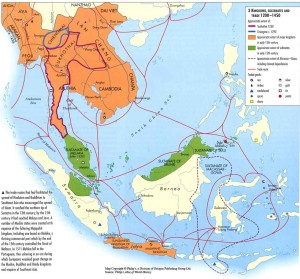
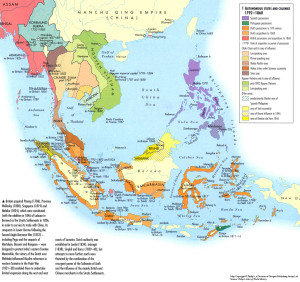
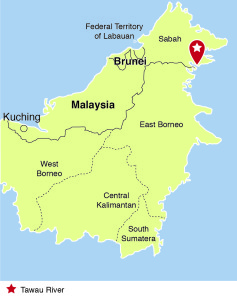
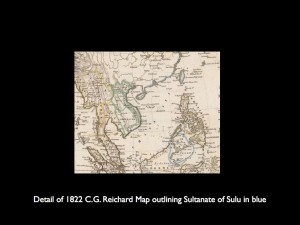
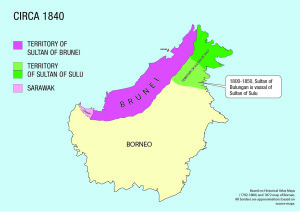
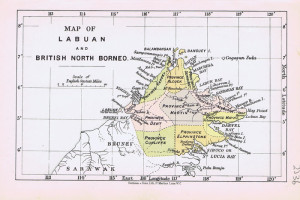
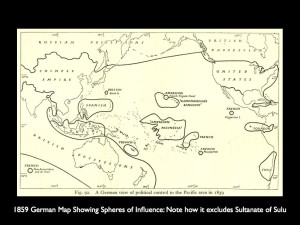
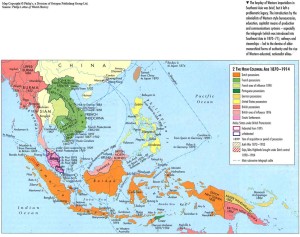
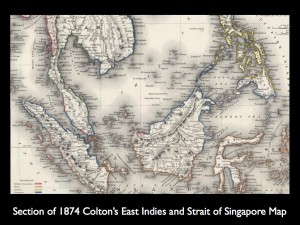
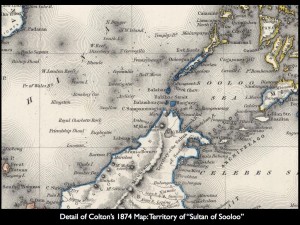
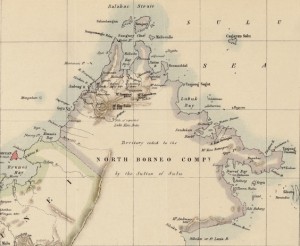
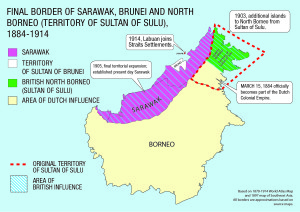
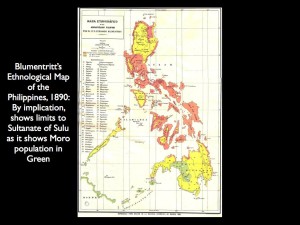
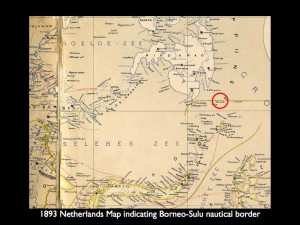
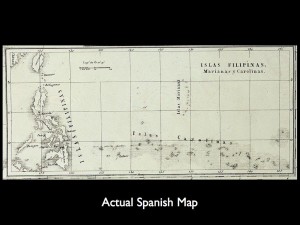
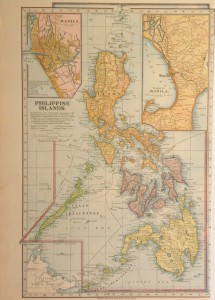
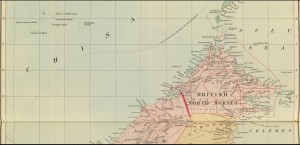
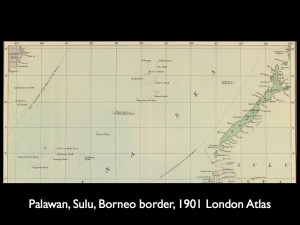
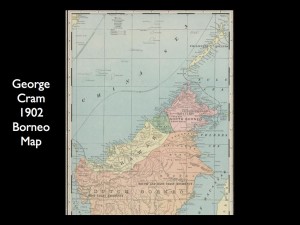
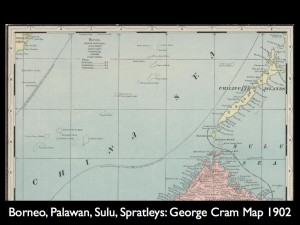
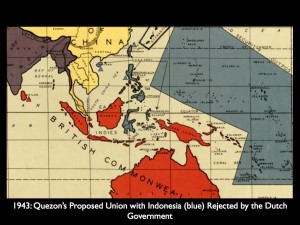
No comments:
Post a Comment